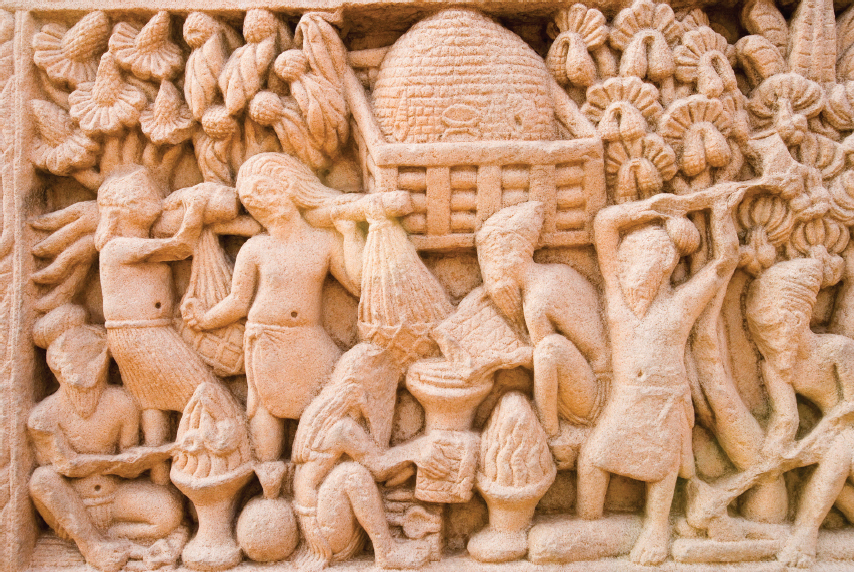Life in Medieval India
Local institutions played a much larger role in the lives of people in medieval India than did the state. Craft guilds oversaw conditions of work and trade, local councils handled law and order at the town or village level, and local castes gave members a sense of belonging and identity.
Like peasant societies elsewhere, including in China, Japan, and Southeast Asia, agricultural life in India ordinarily meant village life. The average farmer worked a small plot of land outside the village. All the family members pooled their resources under the direction of the head of the family. These joint efforts strengthened family solidarity.
The agricultural year began with spring plowing. The traditional plow, drawn by two oxen wearing yokes and collars, had an iron-
Farmers also raised livestock. Most highly valued were cattle, which were raised for plowing and milk, hides, and horns, but Hindus did not slaughter them for meat. Like the Islamic and Jewish prohibition on the consumption of pork, the eating of beef was forbidden among Hindus.

Local craftsmen and tradesmen were frequently organized into guilds, with guild heads and guild rules. The textile industries were particularly well developed. Textiles were produced in large quantities and traded throughout India and beyond. The cutting and polishing of precious stones was another industry associated closely with foreign trade.
In the cities shops were open to the street; families lived on the floors above. The busiest tradesmen dealt in milk and cheese, oil, spices, and perfumes. In addition to these tradesmen and merchants, a host of peddlers shuffled through towns and villages selling everything from needles to freshly cut flowers.
During the first millennium C.E., the caste system reached its mature form. Within the broad division into the four varnas (strata) of Brahmin, Kshatriya, Vaishya, and Shudra (see “Life in Early India” in Chapter 3), the population was subdivided into numerous castes, or jati. Each caste had a proper occupation. In addition, its members married only within the caste and ate only with other members. Members of high-
Eventually Indian society comprised perhaps as many as three thousand castes. Each caste had its own governing body, which enforced the rules of the caste. Those incapable of living up to the rules were expelled, becoming outcastes. These unfortunates lived hard lives, performing tasks that others considered unclean or lowly.
For all members of Indian society regardless of caste, marriage and family were the focus of life. As in China, the family was under the authority of the eldest male, who might take several wives, and ideally sons stayed home with their parents after they married. The family affirmed its solidarity by the religious ritual of honoring its dead ancestors — a ritual that linked the living and the dead, much like ancestor worship in China (see “Shang Society” in Chapter 4). People commonly lived in extended families: grandparents, uncles and aunts, cousins, and nieces and nephews all lived together in the same house or compound.
Children in poor households worked as soon as they were able. Children in wealthier households faced the age-
A wife was expected to have no life apart from her husband. A widow was expected to lead the hard life of the ascetic: sleeping on the ground; eating only one simple meal a day; wearing plain, undyed clothes without jewelry; and shaving her head. She was viewed as inauspicious to everyone but her children, and she did not attend family festivals. Among high-
Within the home the position of a wife depended on her own intelligence and strength of character. Wives were supposed to be humble, cheerful, and diligent, even toward worthless husbands. As in other patriarchal societies, however, occasionally a woman ruled the household. For women who did not want to accept the strictures of married life, the main way out was to join a Buddhist or Jain religious community (see “The Appeal and Impact of Buddhism in China” in Chapter 7).
>QUICK REVIEW
How would you characterize Hindu-